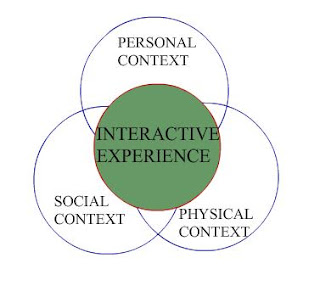=The Museum Experience=
== Reference ==
*Book: John H. Falk, Lynn D. Dierking. The Museum Experience. Whalesback Books,
== Synopsis ==
Museums have their origins and inseparable missions of basic research and public education. However, unlike schools and universities, the audience is self –selected, and the learning is self-directed. The Museum Experience systematically examines the conditions for museum learning for visitor’s perspectives, and “attempts to present the ‘big picture’ of the common, but still poorly understood, use by the public of places like science centers, art museums, history museums, historical homes, nature centers, aquaria, botanical gardens, and zoos.”
The Interactive Experience Model was created as a framework to present a coherent picture of the visitor’s total museum experience.
image:The_experience_model
The personal context incorporates a variety of experiences and knowledge, including visitor's interests, motivations, concerns, and varying degrees of experience in and knowledge of the content and design of the museum.
*Social Context
Social Context includes that if the visitor was in a group or alone; the mesuem was crowded or empty; the interactions with museum staff, volunteers and other visitors.
*Physical Context
The physical context includes the architecture and 'feel' of the building, as well as the objects and artifacts contained within.
The analyses in this book are not 
== Reflection ==
The Interactive Experience Model is created to understand the museum experience at museums. It can be used to analyze the theories in Human-Centered Design field. We do user study in target audiences’ personal context, do usability test in physical context. And comparing the coming of the third wave of the human-computer interaction design, social context get more and more attention from designers, user-experience and co-experience are both important terms considered during design processes. It is a useful framework to analysis an experience. However, the three contexts are inseparable and melted into the reality world. How can we create more and more effectively applicable methods for designers based on the Interactive Experience Model?
Another thing worth to mention is that learning is a long-term effect. “People learn best those things they already know about and that interest them, and people are interested in those things they learn best.”

0 Comments:
Post a Comment
<< Home